
Lechenaultia biloba, commonly known as blue leschenaultia, is a species of flowering plant in the family Goodeniaceae and is endemic to the south-west of Western Australia. It is a glabrous herb or subshrub with spreading branches, almost no leaves, and yellow, tube-shaped flowers.

Conospermum glumaceum, commonly known as hooded smokebush, is a species of flowering plant in the family Proteaceae and is endemic to the south-west of Western Australia. It is an erect shrub with more or less clustered, linear leaves, and panicles of dense, head-like spikes of tube-shaped, cream-coloured flowers and white to golden nuts.

Calytrix aurea is a species of flowering plant in the myrtle family Myrtaceae and is endemic to the south-west of Western Australia. It is a shrub with elliptic, lance-shaped or linear leaves and clusters of yellow flowers with 25 to 55 yellow stamens in several rows.

Darwinia pinifolia is a species of flowering plant in the family Myrtaceae and is endemic to the southwest of Western Australia. It is a low, spreading to prostrate shrub with linear leaves and dense heads of erect, red to purple flowers.

Darwinia thymoides is a species of flowering plant in the myrtle family Myrtaceae and is endemic to the south-west of Western Australia. It is a low, spreading to prostrate shrub with linear to lance-shaped leaves and groups of 4 to 8 green, red or white flowers surrounded by leaf-like bracts.

Calytrix acutifolia is a species of flowering plant in the myrtle family Myrtaceae and is endemic to south-west of Western Australia. It is a slender, openly-branched shrub with linear to lance-shaped leaves and clusters of white, cream-coloured or yellow flowers with 40 to 85 white stamens in several rows.

Calytrix angulata, commonly known as yellow starflower, is a species of flowering plant in the myrtle family Myrtaceae and is endemic to the south-west of Western Australia. It is a shrub with linear to egg-shaped leaves and clusters of yellowish-cream coloured flowers with 30 to 40 yellow stamens in several rows.
Calytrix breviseta is a species of flowering plant in the myrtle family Myrtaceae and is endemic to the south-west of Western Australia. It is a more or less glabrous shrub with egg-shaped, elliptic, lanceolate, oblong or linear leaves and clusters of purple flowers with about 25 to 65 white stamens in several rows, becoming reddish-purple as they age.
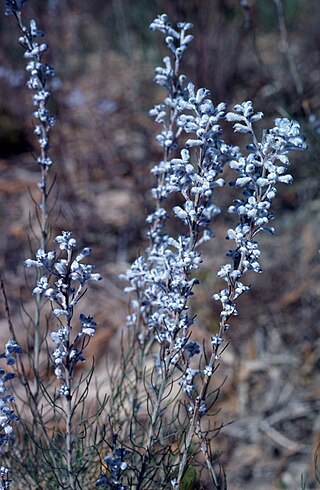
Conospermum brachyphyllum is a species of flowering plant in the family Proteaceae and is endemic to the south-west of Western Australia. It is an open shrub thread-like leaves, and panicles of woolly, white flowers.

Conostephium minus, common name pink-tipped pearl flower, is a species of flowering plant in the family Ericaceae and is endemic to the southwest of Western Australia. It is an erect shrub with linear leaves and white and purplish-pink flowers.

Lechenaultia juncea, commonly known as scarlet leschenaultia, is a species of flowering plant in the family Goodeniaceae and is endemic to the south-west of Western Australia. It is an open, ascending shrub with narrow, crowded, rather fleshy leaves, and scarlet to orange-red flowers.
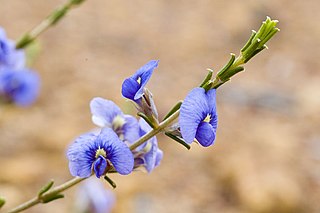
Mirbelia floribunda, commonly known as purple mirbelia, is a species of flowering plant in the family Fabaceae and is endemic to the south-west of Western Australia. It is an erect, slender or straggling, much-branched shrub with narrowly linear leaves and bluish-purple flowers.
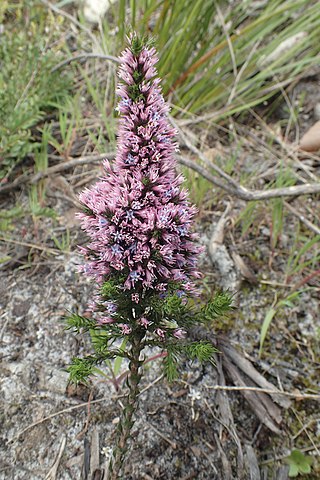
Andersonia caerulea, commonly known as foxtails, is a species of flowering plant in the family Ericaceae and is endemic to the southwest of Western Australia. It is an erect or spreading to low-lying shrub with variably-shaped leaves and pink and pale blue flowers, sometimes in spike-like groups.
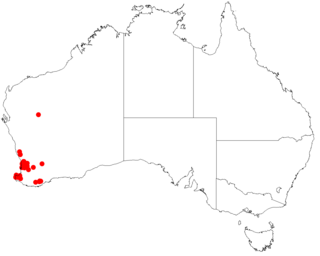
Leucopogon tenuis is a species of flowering plant in the heath family Ericaceae and is endemic to the southwest of Western Australia. It is an erect shrub with slender, wand-like branches, linear or narrowly lance-shaped leaves and white, tube-shaped flowers arranged in cylindrical spikes on the ends of branches.
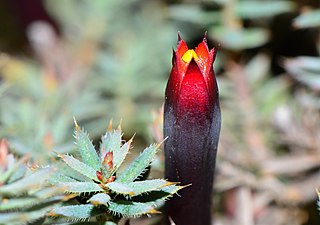
Styphelia discolor is a species of flowering plant in the heath family Ericaceae and is endemic to the south-west of Western Australia. It is a shrub, usually with prostrate stems and spreading, tapering linear leaves and almost sessile red flowers.
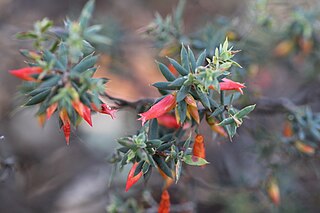
Styphelia epacridis is a flowering plant in the family Ericaceae and is endemic to the south-west of Western Australia. It is a straggling shrub with lance-shaped or linear leaves with a sharp point on the tip, and red, tube-shaped flowers arranged singly in leaf axils.

Styphelia microdonta is a species of flowering plant in the heath family Ericaceae and is endemic to the south west of Western Australia. It is an erect shrub with sharply-pointed, lance-shaped leaves and red, tube-shaped flowers that are bearded inside.

Styphelia serratifolia is a species of flowering plant in the heath family Ericaceae and is endemic to the south-west of Western Australia. It is an erect, bushy shrub, with broadly egg-shaped leaves with the narrower end towards the base, and red, tube-shaped flowers arranged singly in leaf axils.
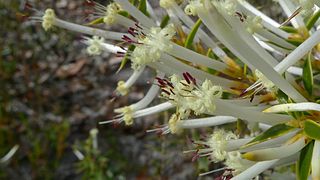
Styphelia tenuiflora, commonly known as common pinheath, is a species of flowering plant in the heath family Ericaceae and is endemic to the south-west of Western Australia. It is an erect shrub with broadly egg-shaped to lance-shaped leaves and whitish-cream, tube-shaped flowers with hairy lobes.
Andersonia auriculata is a species of flowering plant in the family Ericaceae and is endemic to southern Western Australia. It is an erect or spreading shrub with twisted lance-shaped leaves and white or blue flowers.


















